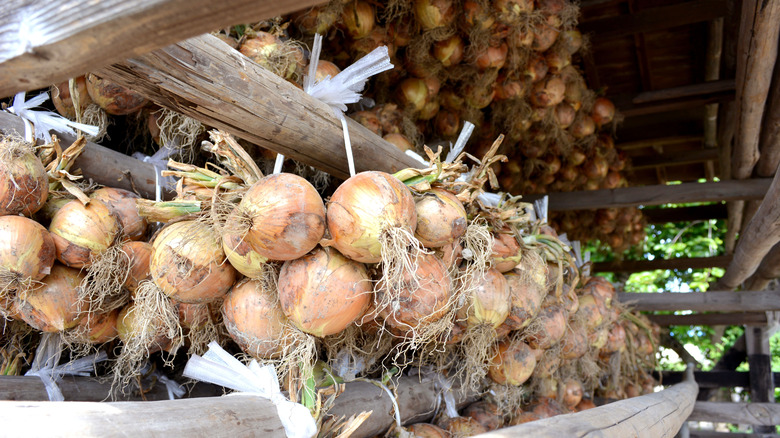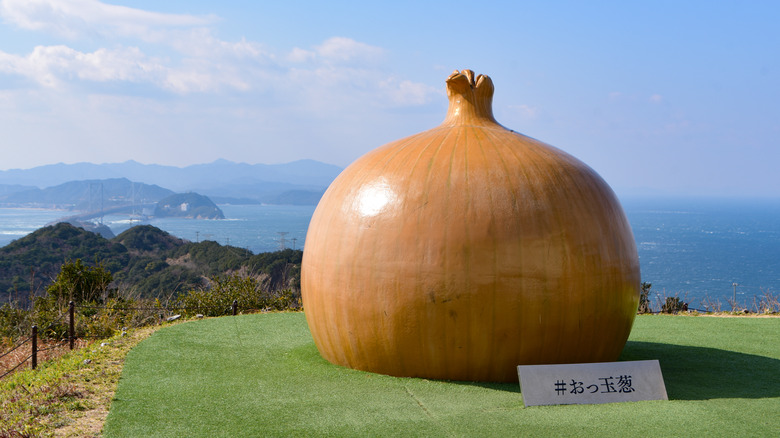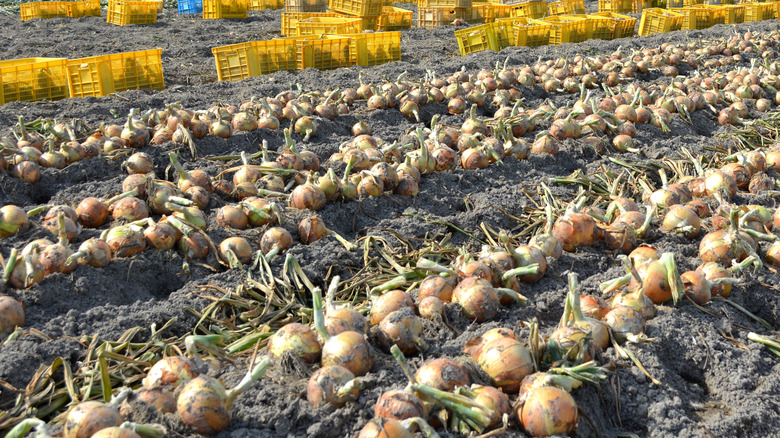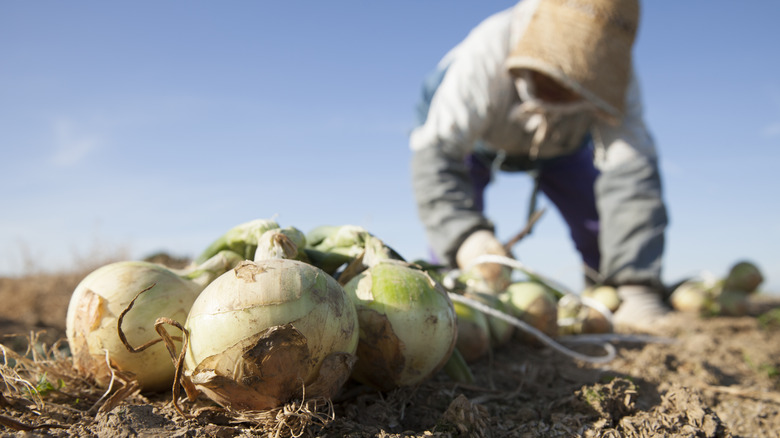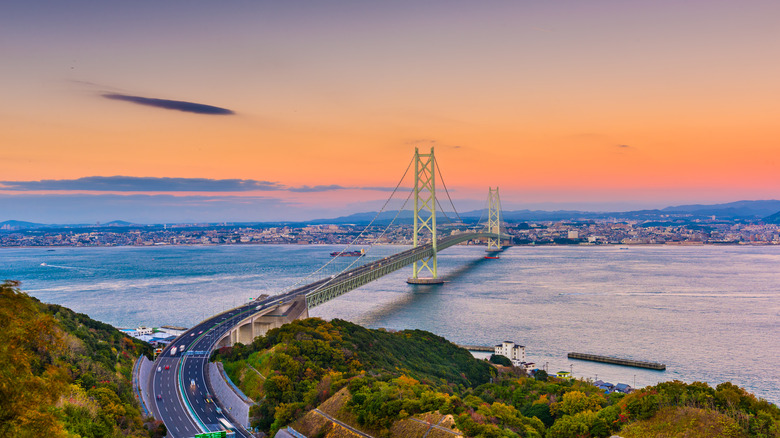Japan's Awaji Island Is Famous For Its Ultra-Sweet Onions
Japan's Awaji Island is located in the Hyōgo Prefecture and the Seto Inland Sea, connecting the famed beef capital Kobe City and whirlpool-rich Naruto. On its own, the lovely island is home to many impressive things, including the dazzling 14th-century Sumoto Castle, the world's longest suspension bridge, and an entire theme park devoted to Godzilla. Even with all of these fantastic features, Awaji has one particular gem hidden underground: the divinely sweet Awaji onion.
As one of Japan's top onion-producing areas, second only to Hokkaido, Awaji can also claim a special onion that has unparalleled sweetness and size. For its prefecture alone, it supplies 95% of its onion produce, according to Nihonmono. And during the month of April, as the onions become ready to harvest, the entire Southern tip of the island smells of the allium. It's even been incorporated into the island's tourism, with a giant onion statue, known as Ottamanegi, serving as particularly Instagram-friendly fodder for tourists. But how did this island's history become intertwined with an onion?
History of Awaji onions
Awaji Island has long been considered a "Food Island" for Japan (via The Setouchi Cookbook). In the eighth century, their agricultural bounty was fed to the Emperor and their royal family, and even the drinking water was brought fresh from Awaji's springs. Still, the yellow onion wasn't introduced to Awaji's fertile soil until the 1880s. This innovation coincided with the introduction of Western dishes into Japan's cuisine, which often used yellow onions as a recipe ingredient.
Farmers found that the onions particularly flourished in Awaji's well-drained, mineral-rich soil, a byproduct of the seawater brought by the surrounding Harimanada Sea, Osaka Bay, and the Kii Channel. One of the magical side effects of this sea-water-enriched soil? Fireflies come in droves to the onion fields in the summertime, attracted to the minerals.
As the years went on, the farmers learned how to make the Awaji onion a year-round crop with the introduction of "new" onions, aka young onions harvested in the spring, alongside the traditional autumn harvest onions. Japan embraced the Awaji onion as a prized ingredient akin to the nearby Kobe beef, incorporating the sweet allium into their seawater pickles, stir-fries, and steamed foods.
The special sweetness of the Awaji onion
For such rapturous fanfare, you'd expect this onion to pack a special flavor. We're here to tell you that the hype is not only real, it can be backed up by science. The Awaji onion receives rave reviews for being one of the sweetest onions on the market, akin to the sugary flavor of the American South's Vidalia onion.
While most onions rate about a 7 on the sugar scale, the Awaji onion clocks in at a 9. Awaji onions that have been left to dry and age can even have a natural sugar content higher than a fresh watermelon. Add to this their lack of pungency, and they make for one of the most desirable alliums around. Think of how all this sweetness would work in an onion soup or caramelized onion burger topper.
Beyond its unparalleled sweetness, the onion is known for its juicy and crispy texture, lending itself well to some raw formats, whether sliced for a salad or to top a sandwich or chopped and blended into a vinaigrette. But to understand the full flavorful and textural nuances of the Awaji onion, you have to learn about the two different varieties.
The two types of Awaji onion
The two styles of Awaji onions are defined by the time at which they are harvested. The "new" onion, called shin-tamanegi in Japanese, is primarily harvested between March and May, yielding a sweet onion with a slightly spicy bite that is particularly enjoyable raw. The papery skin is thin, and the flesh of the onion is very tender. Think of their flavor as spicier than a mild leek but sweeter and more mellow than a red onion. While it is delightful raw, it can also be served with minimal cooking, such as light steaming or flash stir-fries, where its natural flavor and juices can meld nicely with other fresh ingredients.
The second form of the Awaji onion is gathered in August and September — but it isn't ready for consumption directly after harvesting. Instead, these onions are held back and dried out in sheds for a couple of months to help further develop their sweetness. Once they've been properly aged, they're sold as cooking onions, meant to be stirred into stews, tossed into curries, or layered into long-simmering sauces.
Onion-tastic activities on Awaji Island
If you're looking to enjoy the wonders of the Awaji onion, you'll need to book a trip to this majestic island, as their flavor is confined to the specific soil and growing methods intrinsic to the Awaji. However, if you make this allium pilgrimage, you'll be rewarded with plenty of ways to enjoy this local specialty. During the spring, you can enjoy dishes focused on shin-tamanegi, like the classic Onion Ohitashi, a steamed onion served with a pat of butter and soy sauce.
Throughout the year, you can enjoy the island's famed onion burger at the Awaji Island Onion Kitchen, where a rich beef burger is combined with a jumbo fried onion ring. Elsewhere, you can get a bowl of ramen served with stir-fried onions or an onion-forward version of okonomiyaki, a kind of vegetable pancake. Of course, you can start at the source and buy fresh Awaji onions at any local market.
You can have a more abstract onion adventure and admire the onion statue at the bridge overlook, or buy a plush toy version of "Slime," an onion-shaped character on the popular anime show "Dragon Quest" at the Awaji Island Dragon Quest theme park. You could also head to Uzu no Oka Oonarutokyou Memorial Hall to experience a one-of-a-kind UFO catcher. With the Tamanegi UFO Catcher, you can use a metal claw for fishing out a fresh Awaji onion. That's an arcade game any cook can get behind.
